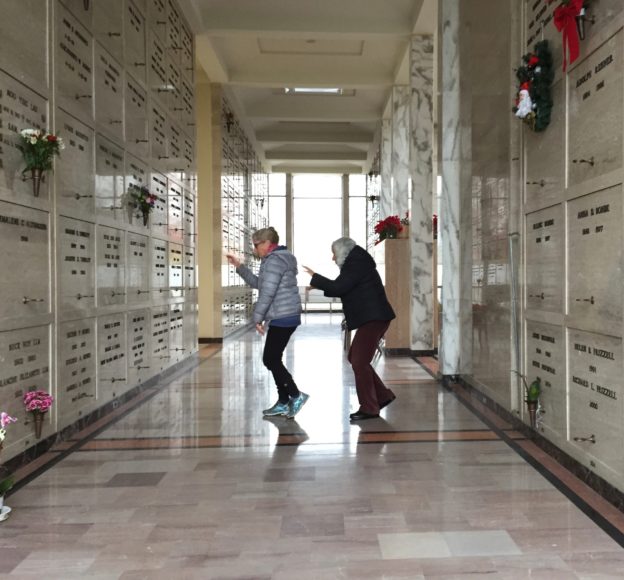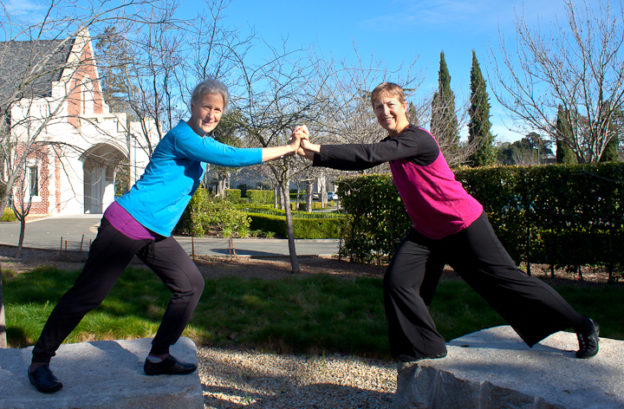As dancers over 65, we have been leading free movement and dance explorations in Oakland’s Mountain View Cemetery for the past four years as part of our project Walking in Witness to Life and Loss. Our collaboration continues to evolve as we mine the complex intersections of life, death and dance within the vibrant natural life of the cemetery. Here we reflect on how we first came to work together and the surprising places it has taken us.
Kaethe: When I moved to Berkeley in 2013 from Boston, where I had lived since graduating college in 1969, I knew I wanted to dance again. I had last danced in college in a Graham-inspired program, and then pursued a career as a psychologist and academic at Harvard Medical School. I hadn’t danced in over forty-five years! Where in this new home could I find meaningful dance opportunities for women over sixty? After many disappointing leads, a phone call to Luna Dance in Berkeley led me to Greacian and her IMPROMPTU NO TUTU elder dance ensemble in the East Bay.
Greacian: I also danced in college but focused primarily on literature and writing and then visual art in graduate school. I returned to dance with new purpose in 1986 when my father died by suicide. This gut-level shock abruptly shifted my primary expression from photography to performance art. Moving as a performer, rather than observing passively, was essential for me to make sense of this loss. I completed an MFA at California College of Arts and Crafts (now CCA) in 1990 as the first graduate in Interdisciplinary Performance Art. Since there was no dance offered at CCA I took classes in the community, most memorably on trapeze with Terry Sendgraff. I also studied theater and dance improvisation inspired by the participatory work of Anna Halprin and Liz Lerman. Later I received an Orff Schulwerk certification in movement and music for all ages.

I became a teaching artist and have worked throughout the Bay Area in venues ranging from the San Francisco Conservatory of Music to the city dump (Recology’s artist residency). I am committed to strengthening community and building hope through art. In 2008, I founded IMPROMPTU NO TUTU, the elder ensemble that Kaethe joined, to show the world what movement from the experience of a long life can be.
Kaethe: I took classes with Greacian and participated in IMPROMPTU NO TUTU events for a year. She then invited me to create a duet with her for a performance with Dance Generators, the intergenerational company based at University of San Francisco. We met regularly to rehearse at Mountain View Cemetery in Oakland, conveniently located for both of us.
Greacian: I have been practicing T’ai Chi in and around the cemetery for years. It’s quiet, obviously, but not as much as you might think. I’m at home in unusual sites and Kaethe shared my fascination with the physical and social space of this large urban oasis.
Kaethe: While developing the duet we both realized that our previous work—for me, in communities in the aftermath of violence, and for Greacian, offering artistic means for elders to stay connected to life through imagination and community—had led us to develop many shared values and practices. I first saw how similar Greacian’s pedagogy was to mine by taking her dance classes. Her way of both structuring and participating in the classes was the movement equivalent of how I teach psychology. We both have enormous respect for people’s creative potential and relish the process of creating open-ended opportunities for exploration.
Greacian: After our duet performance in 2015, which memorialized what would have been our parents’ 100th birthdays, we felt we had just touched the first layer of creative exploration together. The cemetery had deepened the themes in our duet and we committed to meeting there weekly to improvise and see what else would emerge.
Kaethe: The cemetery is essentially our silent third collaborator. While dancing there we have a visceral experience of being alive, in motion, and looking at our ultimate, inevitable end. We are moving in this beautiful container of death.
Greacian: In early 2016 we began designing monthly movement labs for dancers from IMPROMPTU NO TUTU and others from the community. They continue at no charge in the present. Each month a different group gathers to improvise in the cemetery using concepts and scores we have evolved from our own movement research on site.
We call our project Walking in Witness to ground us in a basic movement form that unites many visitors to the cemetery.
For our first Memorial Day lab, Kaethe had suggested we work with the theme of witnessing, since she realized that each previous lab had been an experience of witnessing. This was a term I often use in a poetic sense and had experienced via Authentic Movement, but she meant it in a very specific way from her clinical and community work.
Kaethe: As a trauma specialist I have spent most of my professional life working with witnessing. I have published many articles and a book, Common Shock, Witnessing Violence Every Day: How We Are Harmed, How We Can Heal (Dutton, 2003). While most people are familiar with the terms “victim” and “perpetrator,” few are aware that by far the majority of violence and violation we experience comes through the witness position. This is not the same as “bystander,” which implies that the person standing by is unaffected.
Witnessing is a two-sided coin: one side is harmful to the witness, but the other side can be healing. As a clinician I had worked with a form of witnessing practice originated by the anthropologist Barbara Myerhoff with a Jewish community in Venice, California (documented on film and in the book Number Our Days). She developed a storytelling technique that allowed these elderly displaced persons to “re-member” their lives. “Re-membering,” more than simple recollection, is a communal engagement in witnessing and reflection that offers opportunities for reviving and re-embodying what has been lost or diminished.
Greacian: We transformed Myerhoff’s spoken language process into a nonverbal movement and dance score in which each dancer moves to commemorate a person or idea she wishes to “re-member,” with the group silently witnessing. Then the group reflects the movements they saw, with the dancer observing. Next, the original mover can incorporate new insights into her movement remembrance while the group joins in.
Working with Myerhoff’s ideas in this form deepened my belief in the necessity of moving together in community. The body’s natural language is such an overlooked resource for reflecting on experiences, especially when words are at a loss. We will continue to bring this important process to older adult groups coping with transition and loss, which are so prevalent in later life.
Kaethe: This past September we worked with an intergenerational audience when we participated as one of five artist projects chosen for the Oakland Museum’s Around the Block: A Day of Neighborhood Stories. We created an interactive performance and installation for a plaza at Laney College titled HOME IS WHERE.
Greacian: We wanted to highlight the vital issue of housing in Oakland – to acknowledge the stress of living under the threat of displacement and loss of a safe home, particularly for elders. And to provide a creative way to reflect on it.
Kaethe: We also wanted to seed the idea that experiences of home are rooted in more than the physical space – they are built from relationships, shared time, and memories of feeling at home.
Greacian: To incorporate voices of long-time Oakland residents, I met with participants at the downtown Center for Elders Independence, where I have taught a movement and music class for many years, to ask the question: “home is where…?”

Kaethe: We transformed the responses into haiku-like gestures as the basis for an easily learned movement chorus. On the day of the event we worked with our visitors’ thoughts about home in the same way, creating “instant dances” knitted together with the movement chorus. Later visitors could leave additional thoughts on postcards that decorated the trees in the plaza.
Greacian: We definitely sparked a deep conversation that allowed diverse people and age groups to interact. I think this project is the start of something that will thread through our work in other forms and venues. We’ll bring this theme into future movement labs in the cemetery as well. We recognize we are working in a time of great national upheaval affecting everyone. People need a place for safe freedom of expression and we offer that.
Kaethe: Besides our annual Memorial Day “re-membering,” we observe occasions such as the solstice, new year, and significant local and cultural events. Our weekly explorations and now this recent project have given rise to many percolating ideas about what we will do next.
Greacian: We’ve been so busy talking about our work, I want to make sure to say how grateful I am for our collaboration—twin rivers of rigorous creative inquiry and exhilarating freedom of movement! This is one of the main things keeping me hopeful in this political moment.
Kaethe: Yes, our creative dialogue keeps us focused on what matters most. And I think there are more visitors to the cemetery these days. It seems that others also find it a place to ground in what matters most. Of course, there are probably some who wonder why we would choose to dance in a cemetery. But it is precisely here, in this beautiful place, looking directly at mortality, where we feel most alive. We hope those who see us moving feel something similar.
Learn more about Walking in Witness
Special thanks to Ingeborg Weinmann for work on an early draft.
This article appeared in the December 2018 edition of In Dance.

